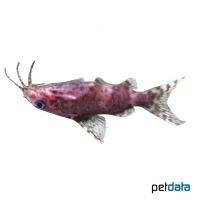Upside Down Catfish (Synodontis nigriventris)
| Upside Down Catfish Synodontis nigriventris | |
|---|---|
| Name | Upside Down Catfish |
| Name Lat. | Synodontis nigriventris |
| Family | Upside-down Catfishes |
| Family lat. | Mochokidae |
| Order | Catfishes |
| Order lat. | Siluriformes |
| Origin | Congo |
| Habitat | Rivers, lakes |
| Diet | Omnivore |
| pH | 6.0-7.5 |
| Behavior | Peaceful |
| Keeping | Group |
| Care Level | Moderate |
| Reproduction | Substrate spawner |
| Breeding | Difficult |
| Life Span | 7-9 years |
| Protection | No |
| Metric Units | |
| Size | 8-10 cm |
| Temperature | 22-28 °C |
| Hardness | 5-20 °dH |
| Aquarium | ~ 200 l |
| US Units | |
| Size | 3"-4" |
| Temperature | 72-82 °F |
| Hardness | 89-356 ppm |
| Aquarium | ~ 50 gal |
Distribution and habitat
The distribution area of the backswimming Congo catfish is the Congo Basin from Pool-Malebo (formerly Stanley Pool) to Mousembe. There they live in lakes and slow flowing rivers with dense riparian vegetation.
Maintenance
They require an aquarium with dense planting that floods to the surface, with many hiding places such as stone caves (e.g. perforated rock) and roots A sandy dark substrate and subdued light (floating plants) is ideal.
No ammonia, ammonium and nitrite should be detectable, the nitrate value should not exceed 100 mg/l. To ensure the water quality and oxygen content, a filter and heater adapted to the aquarium size is required, as well as lighting for the species-appropriate day-night rhythm of the animals.
Diet
They are easy to feed and will accept any type of live or frozen food, such as daphnia, cyclops, mysis, artemia and black mosquito larvae, as well as dry catfish food (granules, flake and tablet food). In addition, they need regular vegetable food, such as crushed peas, cucumber slices, mashed leafy and wild vegetables or dry food with high vegetable content (spirulina, kelp)
Only feed as much as will be eaten in a few minutes. A regular and varied diet promotes health and increases resistance.
Behaviour and compatibility
They are crepuscular and nocturnal. These peaceful and sociable fish can be socialized well with other, even smaller peaceful fish. At least 5, but preferably more back swimming Congo Catfish should be kept together.
Basically, only compatible fish species with similar requirements for water conditions and water temperature should be socialized.
Sex dimorphism
The males are more slender than the females. With some experience, the sexes can be determined by the shape of the genital papilla, which is pointed in the male and round in the female.
Reproduction and breeding
They spawn in burrows or attach the clutch to the substrate (plants, panes, etc.) in a dark place. The clutch is cared for by the parents. After about 4 days the fry hatch. Only after 7-8 weeks they begin to swim on the back.
Fry must be fed several times a day with special rearing food (Artemia nauplii). In community tanks breeding is hardly possible, because the spawn is easy prey here.
Important
They usually swim in a supine position, only turning belly down to feed on the bottom. During the day they often stay under roots, under plant leaves, in caves or under stones, also mostly with the belly upwards.
When catching them, use nets with as fine a mesh as possible to prevent the hard rays of the pectoral and dorsal fins from getting caught, which can cause painful stinging injuries when touched.
When fishing, use the finest mesh nets possible to avoid snagging the hard rays of the pectoral and dorsal fins, which can cause painful puncture wounds when touched.
The well-being of the fish should be checked regularly. Temperature should be checked daily, pH, hardness and nitrate levels at least every 14 days. Regular partial water changes are recommended, even when contaminant levels have not yet reached the upper limit. Sudden changes in water quality should be avoided. Newly introduced fish must be accustomed slowly to the water in the aquarium.
Further literature can be found in your pet store.
References
Text: Werner Winter; Image: petdata
Source: BMEL (1998): Tierschutzgutachten - Haltung von Zierfischen (Süßwasser); RIEHL & BAENSCH (2006): Aquarien Atlas Bd. 1, Mergus Verlag; ENGELMANN (2005): Zootierhaltung - Tiere in menschlicher Obhut: Fische, Verlag Harri Deutsch
- Gemäß § 21 Abs. 5 Tierschutzgesetz idgF
